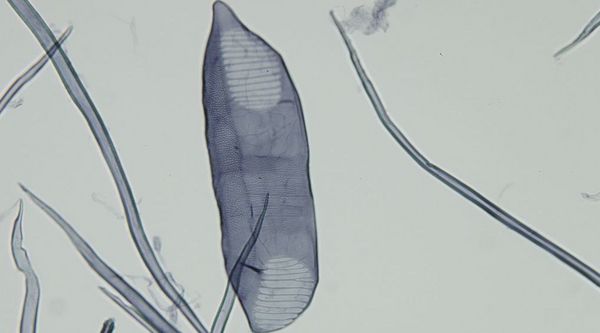Project
Automated image recognition for wood species identification

Can wood species be identified with absolute certainty using machine learning?
We are working on this question in the FNR project in collaboration with the Fraunhofer Institute. The aim: automated image recognition systems for wood species identification.
Background and Objective
To support deforestation-free supply chains, the wood species used in products are determined at the Thünen Centre of Competence on the Origin of Timber. Routinely, cut specimens of wood and, in the case of fibrous materials such as paper, isolated cells are examined under a light microscope and analyzed by experts in a time-consuming process. Automated image recognition systems can significantly reduce the workload and the time required.
In the project in cooperation with the Fraunhofer Institute ITWM, machine-learning systems are being trained. The successfully developed systems for the recognition of hardwoods from the previous project KI_Wood-ID will be supplemented by additional softwood systems in the WoodFiberID project. Together, these will be combined in an image evaluation software that can be used to analyze microscopic images of paper specimens. The results will be published scientifically and provided to all testing institutes for the control of internationally traded wood.
Target Group
Authorities, science, timber trade and consumers
Approach
For a selection of relevant timbers, samples from the scientific collection and other documented sources are processed into realistic training and test specimens. In the slide scanning microscope specially acquired for the previous project, 100 slides can be inserted simultaneously. Automated microscopic images are then taken in multiple focal planes over the entire slide area. These images represent the important data basis of the project. In these images, the characteristic morphological features that are essential for the identification of the wood genus by wood anatomists are labeled. Machine learning systems are trained and validated with these at the ITWM.
Microscopic images of fibrous materials can already be analyzed by the first prototype user interface developed in the previous project. The machine-learning systems can already identify eleven hardwood species with whose references they have been trained. Below you can see how the cells that are important for identification are first detected in the image and then classified. The identified cells can then be checked for plausibility by wood anatomists.
In the current project, the focus is now on softwoods and non-wood raw materials such as grasses and sugar cane bagasse, which are increasingly being used in fibrous materials. For softwoods in particular, completely independent models have to be trained because a completely different cell type has to be used to identify the type of wood.
First web-based user interface for automated wood species identification in paper
Our Research Questions
Can machine learning also identify softwoods and non-wood fibers in fibrous materials?
Links and Downloads
Literature about the project
- 0
Helmling S, Nieradzik L, Sieburg-Rockel IJ, Weibel T, Wrage S, Gospodnetic P, Keuper J, Stephani H, Rauhut M, Olbrich A (2024) Automated wood species identification in microscopic images of fibrous materials using machine learning / AI. In: Forests & society towards 2050 : 26th IUFRO World Congress, Stockholm, Sweden, 23-29 June 2024 ; Book of abstracts. p 3523
- 1
Nieradzik L, Sieburg-Rockel IJ, Helmling S, Keuper J, Weibel T, Olbrich A, Stephani H (2024) Automating wood species detection and classification in microscopic images of fibrous materials with deep learning. Microsc Microanal 30(3):508-520, DOI:10.1093/mam/ozae038
- 2
Nieradzik L, Stephani H, Sieburg-Rockel IJ, Helmling S, Olbrich A, Keuper J (2024) Challenging the black box: A comprehensive evaluation of attribution maps of CNN applications in agriculture and forestry. In: Radeva P, Furnari A, Bouatouch K, Sousa AA (eds) Proceedings of the 19th International Joint Conference on Computer Vision, Imaging and Computer Graphics Theory and Applications (VISIGRAPP 2024). Vol. 2. pp 483-492, DOI:10.5220/0012363400003660
- 3
Nieradzik L, Stephani H, Sieburg-Rockel IJ, Helmling S, Olbrich A, Wrage S, Keuper J (2024) WoodYOLO: A novel object detector for wood species detection in microscopic images. Forests 15(11):1910, DOI:10.3390/f15111910
- 4
Helmling S, Sieburg-Rockel IJ, Wrage S, Olbrich A, Nieradzik L, Stephani H, Weibel T, Gospodnetic P, Rauhut M (2023) Automatisierte Holzartenidentifizierung in mikroskopischen Bildern von Fasermaterialien mit Hilfe von maschinellem Lernen / KI. In: KIDA-Fachtagung, 27. - 28. September 2023, Quedlinburg : Abstractbuch. Braunschweig: Geschäftsstelle Think Tank Digitalisierung, Johann Heinrich von Thünen-Institut, pp 21-22
Involved Thünen-Partners
Involved external Thünen-Partners
- Fraunhofer-Institut für Techno- und Wirtschaftsmathematik ITWM
(Kaiserslautern, Deutschland)
Funding Body
-
Federal Ministry of Food und Agriculture (BMEL)
(national, öffentlich) -
Fachagentur Nachwachsende Rohstoffe e.V. (FNR)
(national, öffentlich)
Duration
11.2024 - 10.2027
More Information
Project funding number: 2224HV008A
Project status:
ongoing









